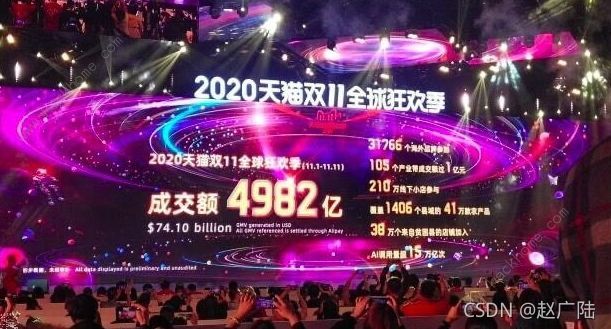大数据Flink实时大屏统计
目录
- 1 需求
- 2 数据
- 3 编码步骤:
- 4 代码实现
- 5 效果
1 需求
Flink模拟双十一实时大屏统计

在大数据的实时处理中,实时的大屏展示已经成了一个很重要的展示项,比如最有名的双十一大屏实时销售总价展示。除了这个,还有一些其他场景的应用,比如我们在我们的后台系统实
时的展示我们网站当前的pv、uv等等,其实做法都是类似的。
今天我们就做一个最简单的模拟电商统计大屏的小例子,
需求如下:
1.实时计算出当天零点截止到当前时间的销售总额
2.计算出各个分类的销售top3
3.每秒钟更新一次统计结果
2 数据
首先我们通过自定义source 模拟订单的生成,生成了一个Tuple2,第一个元素是分类,第二个元
素表示这个分类下产生的订单金额,金额我们通过随机生成.
/**
* 自定义数据源实时产生订单数据Tuple2<分类, 金额>
*/
public static class MySource implements SourceFunction<Tuple2<String, Double>>{
private boolean flag = true;
private String[] categorys = {"女装", "男装","图书", "家电","洗护", "美妆","运动", "游戏","户外", "家具","乐器", "办公"};
private Random random = new Random();
@Override
public void run(SourceContext<Tuple2<String, Double>> ctx) throws Exception {
while (flag){
//随机生成分类和金额
int index = random.nextInt(categorys.length);//[0~length) ==> [0~length-1]
String category = categorys[index];//获取的随机分类
double price = random.nextDouble() * 100;//注意nextDouble生成的是[0~1)之间的随机数,*100之后表示[0~100)
ctx.collect(Tuple2.of(category,price));
Thread.sleep(20);
}
}
@Override
public void cancel() {
flag = false;
}
}
3 编码步骤:
- env
- source
- transformation
3.1定义大小为一天的窗口,第二个参数表示中国使用的UTC+08:00时区比UTC时间早
.keyBy(0)
window(TumblingProcessingTimeWindows.of(Time.days(1), Time.hours(-8))
3.2定义一个1s的触发器
.trigger(ContinuousProcessingTimeTrigger.of(Time.seconds(1)))
3.3聚合结果.aggregate(new PriceAggregate(), new WindowResult());
3.4看一下聚合的结果
CategoryPojo(category=男装, totalPrice=17225.26, dateTime=2020-10-20 08:04:12) - 使用上面聚合的结果,实现业务需求:
result.keyBy(“dateTime”)
//每秒钟更新一次统计结果
.window(TumblingProcessingTimeWindows.of(Time.seconds(1)))
//在ProcessWindowFunction中实现该复杂业务逻辑
.process(new WindowResultProcess());
4.1. 实时计算出当天零点截止到当前时间的销售总额
4.2.计算出各个分类的销售top3
4.3.每秒钟更新一次统计结果 - execute
4 代码实现
package cn.oldlu.action;
import lombok.AllArgsConstructor;
import lombok.Data;
import lombok.NoArgsConstructor;
import org.apache.commons.lang3.StringUtils;
import org.apache.flink.api.common.functions.AggregateFunction;
import org.apache.flink.api.java.tuple.Tuple;
import org.apache.flink.api.java.tuple.Tuple1;
import org.apache.flink.api.java.tuple.Tuple2;
import org.apache.flink.streaming.api.datastream.DataStreamSource;
import org.apache.flink.streaming.api.datastream.SingleOutputStreamOperator;
import org.apache.flink.streaming.api.environment.StreamExecutionEnvironment;
import org.apache.flink.streaming.api.functions.source.SourceFunction;
import org.apache.flink.streaming.api.functions.windowing.ProcessWindowFunction;
import org.apache.flink.streaming.api.functions.windowing.WindowFunction;
import org.apache.flink.streaming.api.windowing.assigners.TumblingProcessingTimeWindows;
import org.apache.flink.streaming.api.windowing.time.Time;
import org.apache.flink.streaming.api.windowing.triggers.ContinuousProcessingTimeTrigger;
import org.apache.flink.streaming.api.windowing.windows.TimeWindow;
import org.apache.flink.util.Collector;
import java.math.BigDecimal;
import java.text.SimpleDateFormat;
import java.util.*;
import java.util.stream.Collectors;
/**
* Author oldlu
* Desc
* 模拟双11商品实时交易大屏统计分析
*/
public class DoubleElevenBigScreem {
public static void main(String[] args) throws Exception{
//编码步骤:
//1.env
StreamExecutionEnvironment env = StreamExecutionEnvironment.getExecutionEnvironment();
env.setParallelism(1);//学习测试方便观察
//2.source
//模拟实时订单信息
DataStreamSource<Tuple2<String, Double>> sourceDS = env.addSource(new MySource());
/*
注意:需求如下:
-1.实时计算出11月11日00:00:00零点开始截止到当前时间的销售总额
-2.计算出各个分类的销售额top3
-3.每1秒钟更新一次统计结果
如果使用之前学习的简单的timeWindow(Time size窗口大小, Time slide滑动间隔)来处理,
如xxx.timeWindow(24小时,1s),计算的是需求中的吗?
不是!如果使用之前的做法那么是完成不了需求的,因为:
如11月11日00:00:01计算的是11月10号[00:00:00~23:59:59s]的数据
而我们应该要计算的是:11月11日00:00:00~11月11日00:00:01
所以不能使用之前的简单做法!*/
//3.transformation
//.keyBy(0)
SingleOutputStreamOperator<CategoryPojo> tempAggResult = sourceDS.keyBy(0)
//3.1定义大小为一天的窗口,第二个参数表示中国使用的UTC+08:00时区比UTC时间早
/*
of(Time 窗口大小, Time 带时间校准的从哪开始)源码中有解释:
如果您居住在不使用UTC±00:00时间的地方,例如使用UTC + 08:00的中国,并且您需要一个大小为一天的时间窗口,
并且窗口从当地时间的每00:00:00开始,您可以使用of(Time.days(1),Time.hours(-8))
注意:该代码如果在11月11日运行就会从11月11日00:00:00开始记录直到11月11日23:59:59的1天的数据
注意:我们这里简化了没有把之前的Watermaker那些代码拿过来,所以直接ProcessingTime
*/
.window(TumblingProcessingTimeWindows.of(Time.days(1), Time.hours(-8)))//仅仅只定义了一个窗口大小
//3.2定义一个1s的触发器
.trigger(ContinuousProcessingTimeTrigger.of(Time.seconds(1)))
//上面的3.1和3.2相当于自定义窗口的长度和触发时机
//3.3聚合结果.aggregate(new PriceAggregate(), new WindowResult());
//.sum(1)//以前的写法用的默认的聚合和收集
//现在可以自定义如何对price进行聚合,并自定义聚合结果用怎样的格式进行收集
.aggregate(new PriceAggregate(), new WindowResult());
//3.4看一下初步聚合的结果
tempAggResult.print("初步聚合结果");
//CategoryPojo(category=运动, totalPrice=118.69, dateTime=2020-10-20 08:04:12)
//上面的结果表示:当前各个分类的销售总额
/*
注意:需求如下:
-1.实时计算出11月11日00:00:00零点开始截止到当前时间的销售总额
-2.计算出各个分类的销售额top3
-3.每1秒钟更新一次统计结果
*/
//4.使用上面初步聚合的结果,实现业务需求,并sink
tempAggResult.keyBy("dateTime")//按照时间分组是因为需要每1s更新截至到当前时间的销售总额
//每秒钟更新一次统计结果
//Time size 为1s,表示计算最近1s的数据
.window(TumblingProcessingTimeWindows.of(Time.seconds(1)))
//在ProcessWindowFunction中实现该复杂业务逻辑,一次性将需求1和2搞定
//-1.实时计算出11月11日00:00:00零点开始截止到当前时间的销售总额
//-2.计算出各个分类的销售额top3
//-3.每1秒钟更新一次统计结果
.process(new WindowResultProcess());//window后的process方法可以处理复杂逻辑
//5.execute
env.execute();
}
/**
* 自定义数据源实时产生订单数据Tuple2<分类, 金额>
*/
public static class MySource implements SourceFunction<Tuple2<String, Double>>{
private boolean flag = true;
private String[] categorys = {"女装", "男装","图书", "家电","洗护", "美妆","运动", "游戏","户外", "家具","乐器", "办公"};
private Random random = new Random();
@Override
public void run(SourceContext<Tuple2<String, Double>> ctx) throws Exception {
while (flag){
//随机生成分类和金额
int index = random.nextInt(categorys.length);//[0~length) ==> [0~length-1]
String category = categorys[index];//获取的随机分类
double price = random.nextDouble() * 100;//注意nextDouble生成的是[0~1)之间的随机数,*100之后表示[0~100)
ctx.collect(Tuple2.of(category,price));
Thread.sleep(20);
}
}
@Override
public void cancel() {
flag = false;
}
}
/**
* 自定义价格聚合函数,其实就是对price的简单sum操作
* AggregateFunction
* AggregateFunction, Double, Double>
*
*/
private static class PriceAggregate implements AggregateFunction<Tuple2<String, Double>, Double, Double> {
//初始化累加器为0
@Override
public Double createAccumulator() {
return 0D; //D表示Double,L表示long
}
//把price往累加器上累加
@Override
public Double add(Tuple2<String, Double> value, Double accumulator) {
return value.f1 + accumulator;
}
//获取累加结果
@Override
public Double getResult(Double accumulator) {
return accumulator;
}
//各个subTask的结果合并
@Override
public Double merge(Double a, Double b) {
return a + b;
}
}
/**
* 用于存储聚合的结果
*/
@Data
@AllArgsConstructor
@NoArgsConstructor
public static class CategoryPojo {
private String category;//分类名称
private double totalPrice;//该分类总销售额
private String dateTime;// 截止到当前时间的时间,本来应该是EventTime,但是我们这里简化了直接用当前系统时间即可
}
/**
* 自定义WindowFunction,实现如何收集窗口结果数据
* interface WindowFunction
* interface WindowFunction
*/
private static class WindowResult implements WindowFunction<Double, CategoryPojo, Tuple, TimeWindow> {
//定义一个时间格式化工具用来将当前时间(双十一那天订单的时间)转为String格式
SimpleDateFormat df = new SimpleDateFormat("yyyy-MM-dd HH:mm:ss");
@Override
public void apply(Tuple tuple, TimeWindow window, Iterable<Double> input, Collector<CategoryPojo> out) throws Exception {
String category = ((Tuple1<String>) tuple).f0;
Double price = input.iterator().next();
//为了后面项目铺垫,使用一下用Bigdecimal来表示精确的小数
BigDecimal bigDecimal = new BigDecimal(price);
//setScale设置精度保留2位小数,
double roundPrice = bigDecimal.setScale(2, BigDecimal.ROUND_HALF_UP).doubleValue();//四舍五入
long currentTimeMillis = System.currentTimeMillis();
String dateTime = df.format(currentTimeMillis);
CategoryPojo categoryPojo = new CategoryPojo(category, roundPrice, dateTime);
out.collect(categoryPojo);
}
}
/**
* 实现ProcessWindowFunction
* abstract class ProcessWindowFunction
* abstract class ProcessWindowFunction
*
* 把各个分类的总价加起来,就是全站的总销量金额,
* 然后我们同时使用优先级队列计算出分类销售的Top3,
* 最后打印出结果,在实际中我们可以把这个结果数据存储到hbase或者redis中,以供前端的实时页面展示。
*/
private static class WindowResultProcess extends ProcessWindowFunction<CategoryPojo, Object, Tuple, TimeWindow> {
@Override
public void process(Tuple tuple, Context context, Iterable<CategoryPojo> elements, Collector<Object> out) throws Exception {
String dateTime = ((Tuple1<String>)tuple).f0;
//Java中的大小顶堆可以使用优先级队列来实现
//https://blog.csdn.net/hefenglian/article/details/81807527
//注意:
// 小顶堆用来计算:最大的topN
// 大顶堆用来计算:最小的topN
Queue<CategoryPojo> queue = new PriorityQueue<>(3,//初识容量
//正常的排序,就是小的在前,大的在后,也就是c1>c2的时候返回1,也就是小顶堆
(c1, c2) -> c1.getTotalPrice() >= c2.getTotalPrice() ? 1 : -1);
//在这里我们要完成需求:
// * -1.实时计算出11月11日00:00:00零点开始截止到当前时间的销售总额,其实就是把之前的初步聚合的price再累加!
double totalPrice = 0D;
double roundPrice = 0D;
Iterator<CategoryPojo> iterator = elements.iterator();
for (CategoryPojo element : elements) {
double price = element.totalPrice;//某个分类的总销售额
totalPrice += price;
BigDecimal bigDecimal = new BigDecimal(totalPrice);
roundPrice = bigDecimal.setScale(2, BigDecimal.ROUND_HALF_UP).doubleValue();//四舍五入
// * -2.计算出各个分类的销售额top3,其实就是对各个分类的price进行排序取前3
//注意:我们只需要top3,也就是只关注最大的前3个的顺序,剩下不管!所以不要使用全局排序,只需要做最大的前3的局部排序即可
//那么可以使用小顶堆,把小的放顶上
// c:80
// b:90
// a:100
//那么来了一个数,和最顶上的比,如d,
//if(d>顶上),把顶上的去掉,把d放上去,再和b,a比较并排序,保证顶上是最小的
//if(d<=顶上),不用变
if (queue.size() < 3) {//小顶堆size<3,说明数不够,直接放入
queue.add(element);
}else{//小顶堆size=3,说明,小顶堆满了,进来一个需要比较
//"取出"顶上的(不是移除)
CategoryPojo top = queue.peek();
if(element.totalPrice > top.totalPrice){
//queue.remove(top);//移除指定的元素
queue.poll();//移除顶上的元素
queue.add(element);
}
}
}
// * -3.每1秒钟更新一次统计结果,可以直接打印/sink,也可以收集完结果返回后再打印,
// 但是我们这里一次性处理了需求1和2的两种结果,不好返回,所以直接输出!
//对queue中的数据逆序
//各个分类的销售额top3
List<String> top3Result = queue.stream()
.sorted((c1, c2) -> c1.getTotalPrice() > c2.getTotalPrice() ? -1 : 1)//逆序
.map(c -> "(分类:" + c.getCategory() + " 销售总额:" + c.getTotalPrice() + ")")
.collect(Collectors.toList());
System.out.println("时间 : " + dateTime + " 总价 : " + roundPrice + " top3:\n" + StringUtils.join(top3Result, ",\n"));
System.out.println("-------------");
}
}
}
